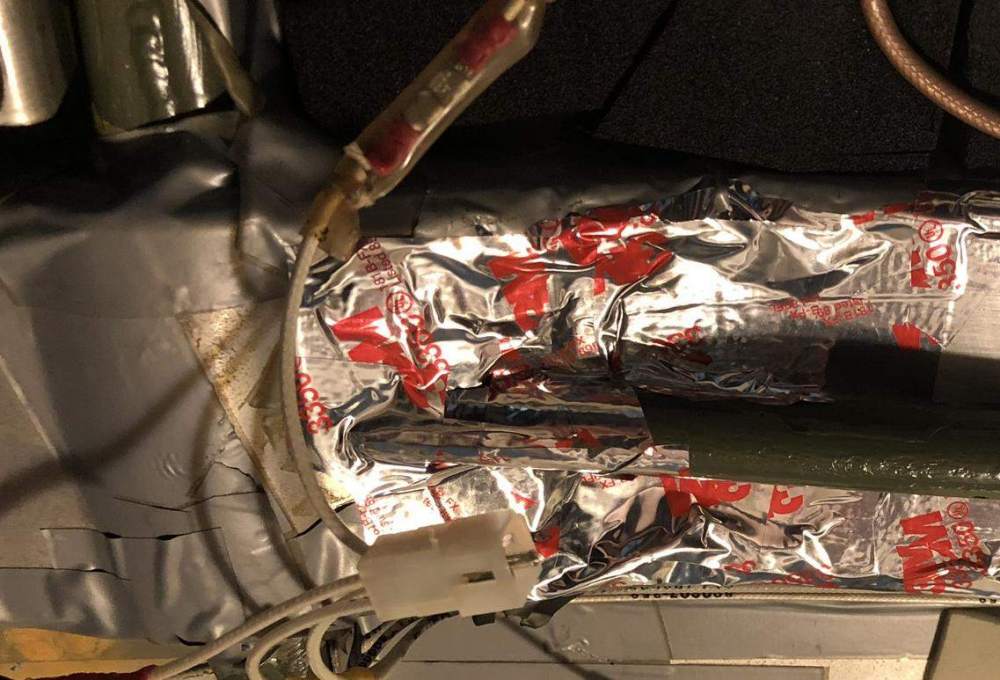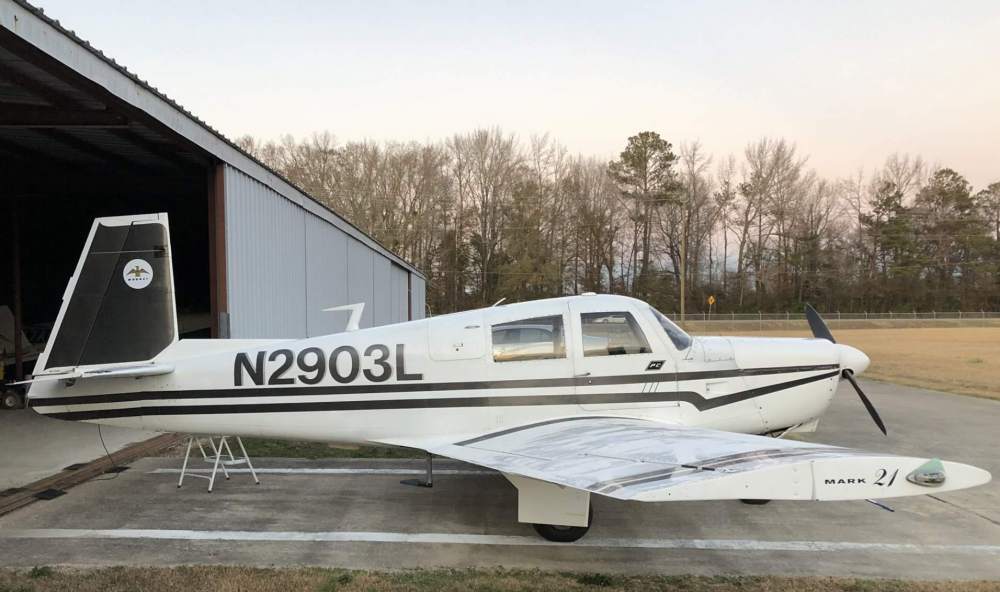-
Posts
3,190 -
Joined
-
Last visited
-
Days Won
8
Everything posted by 0TreeLemur
-

NOAA MOS Extended Ceiling and Visibility No More!
0TreeLemur replied to DualRatedFlyer's topic in General Mooney Talk
The Localized Aviation MOS Program (LAMP) is a potential replacement going out 24 h. I like it. https://www.nws.noaa.gov/mdl/gfslamp/stnplots.php and https://www.weather.gov/mdl/lamp_home I am affiliated with NOAA, but not with their aviation products division. PP only. -
Weird. They just love your plane to death! I'm going with the "rat fell from above" theory @carusoam's suggestion that the lizard died trying to push start the engine is the funniest thing I've heard in a while!
-

Mooney down in CT - N53CP
0TreeLemur replied to TTaylor's topic in Mooney Safety & Accident Discussion
I've never been shown a spring loaded alt air door on our '67C. How does one check that? Photo? Thx. -
Those are new vinyl stickers too. I got those on eBay. Shipped from the Philipines. Cost was minimal, just 3-4 week delivery by snail mail.
-
Video from Fresno, showing a King Air 200 being driven around the ramp by a 17 year old girl who hopped the fence and decided to go for a drive. https://www.cnn.com/2019/12/18/us/teenager-steals-plane-trnd/index.html I don't think I could just climb into a King Air and get it started. Flight sim experience or found a good online video? A for effort, F for taxi skills.
-

Seat covers or seat dimensions M20C
0TreeLemur replied to Urs_Wildermuth's topic in Vintage Mooneys (pre-J models)
@carusoam can probably either: (a) answer this, or; (b) suggest someone who knows. -
Given the importance of occasional SB-208B inspections, I would not use tank sealant there. The 3M 350 tape I used is made from non-absorptive mylar with excellent adhesive properties. I'll be surprised if it isn't still sticking there years from now.
-
Avoid rubber tubing. Modern polymer tubing styles are so much more durable. Nylon is very durable, abrasion resistant, flexible, stiff and clear. Polyethylene- milky but very rugged. That is what runs out to your pitot tube, and out to the vacuum servos.. Even Tygon (expensive but will survive the end of the planet) is great behind the panel. Rugged, expandable, lasts forever. Silicone- great for high temperature apps. Not an A&P but I have worked with tubing much of my career.
-
This picture was taken after I taped it up. Note the tubular steel member coming in from the right. The tape covers a large elliptical hole.
-

Seat covers or seat dimensions M20C
0TreeLemur replied to Urs_Wildermuth's topic in Vintage Mooneys (pre-J models)
Hi @Urs_Wildermuth here is minor correction: I found my little slip of paper that has on it my measurements. The front seat back height is 21-1/2" tall, and only 14" wide because it is tapered toward the top. -
I too have thought about changing my tail number to something more easily intelligible. But then again, she's had it since 1967 and it's worked for all these years. It got better when I started saying it "Two Niner oh Tree Lemur", which occasionally still gets interpreted wrong. Fast thinking controllers still often want to call me some variant of 2X02L. In Australia they just use three letters. The country prefix is VH and the little Cherokee I used to fly was VH-FLV. I suppose in the US with so many more aircraft it would take up to four letters.
-

Seat covers or seat dimensions M20C
0TreeLemur replied to Urs_Wildermuth's topic in Vintage Mooneys (pre-J models)
Niiiiiiiice @Marauder. One question tho- is that passenger seat big enough??? -
I too had a bunch of cold air coming from somewhere in our 1967 C. It seemed to be coming from the overhead area. So during a test flight last weekend I discovered the source. The problem was a major air leak where the tubular steel frame penetrates the dorsal air plenum under the plastic overhead panel. The tape covering that hole was removed when they did the 208B corrosion inspection last summer and not replaced. I taped it up good. Planning a test flight this weekend to see how much that helped. @steingar you might look there.
-

Seat covers or seat dimensions M20C
0TreeLemur replied to Urs_Wildermuth's topic in Vintage Mooneys (pre-J models)
Measured the front seats of my '67C recently for sheepskin seat covers. Bottom is about 17" x 17" and 5" high. The back was 17"W at the bottom, tapering to about 14" wide at the top, is 21-1/2" vertically and 4" thick. The rear bench seat is right about 42" wide, 23" high and the sitting portion lengthwise is again about 17". These are +/- 1" tolerance measurements because I'm an engineer, and measuring fluffy things is hard. Good luck. Anybody know a good source of sheepskins that don't cost arm+leg? -
^^^^^ this.
-
So, the FAA makes the manufacturers of certified engine monitors hide the redline limits from the user, but the manufacturers of NexGen ATC transponders don't have to do the same for HEX codes or use encryption. Anyone with a Garmin gps must use proprietary software to set it up. Why would ADS-B out transponders need to be any different? This is really maddening. It hints that the entire ADS-B system has a fundamental flaw and will require a complete redesign or remain vulnerable. Yippee! Our units don't support encryption! So we all get to suffer a new costly ADS-B related mandate! I'll probably miss the free government money on that one too...
-
I did this the other day in my C, and saw high EGT's. I had low MP (gear warning going off), prop full rpm, mixture about 1" from full rich, in about 1000 fpm descent. EGT's on all cyls. went up causing the EGT bars on the JPI900 to turn yellow. Advanced mixture full rich and that cooled them off. Density altitude 0. I was surprised that this condition could cause high EGTs. In another thread @Shadrach suggests that this is not a concern, just a peculiarity of the situation that won't harm anything.
-
My co-pilot and I added these retro features to the tail and wing tip of our '67C. Just wanted to share. Vinyl decals purchased on eBay.
-
Is the 632215 one of those airfoils that is better with a lot of ice? Not planning on testing the theory, of course, in an aircraft with 960lb UL. Just curious.
- 304 replies
-
- 1
-

-
- aerodynamics
- airflow
-
(and 2 more)
Tagged with:
-

High EGT on rapid descent
0TreeLemur replied to 0TreeLemur's topic in Vintage Mooneys (pre-J models)
Thanks everyone for your replies. Ross, I think you might be on to something here. Come to think of it, I think that I did push the prop control forward to high rpm to get the slight speed brake effect of the prop. Pushing burning gasses out into the exhaust sounds like something to avoid for the sake of the exhaust valves. All cylinders showed increased EGT, not just one. Yes, @Shadrach pushing the mixture in helped to bring all EGT's down. The intake air leak theory is possible @Pasturepilot but wishful thinking, I think, because this was a one-off event indicating stoopid pilot trick not mechanical issue. I think that if in the future there is a need to lose altitude rapidly near the field I should use a slip to lose energy, not high prop rpm. Burnin' and learnin' -Fred -
-

High EGT on rapid descent
0TreeLemur replied to 0TreeLemur's topic in Vintage Mooneys (pre-J models)
Yes- same here. I have an EDM900, and I think the EGT bars turn yellow very near 1450F. I really like that feature. Once I took off without pushing the mixture in, and it was obvious when those bars turn yellow. Another time where having an engine monitor probably paid for itself many times over. I don't often see the yellow bars unless I screw up, and I always run ROP. -Fred -
It would be interesting to test that airfoil. Like you say- probably something better possible now. The optimization problem of cruise performance vs. safety/low speed characteristics is one of the features I liked about that paper. Best, Fred
- 304 replies
-
- 2
-

-
- aerodynamics
- airflow
-
(and 2 more)
Tagged with:
-
Yes, I had an experience during IFR training in March flying through moderate rain. My pitot-tube vent became partly plugged with water causing transients in the pitot-static system, which caused the AV-20S AOA sensor to freak out and start telling me that I had approached or exceeded what it thought was the critical AOA. Very distracting- flashing brightly bad AOA data. In reality my static instruments were extremely happy- nothing had changed and I was in a stabilized descent with low turbulence, the altimeter and VSI both stably indicating 500 fpm descent. After that I contacted Aerovonics, the original mfgr. of the AV-20S. I was told that the AOA sensor is uncalibratable in the Mooney airframe, and that I should disable it, which I did. I bought the AV-20S for (1) timer, (2), backup MEMS attitude indicator, and (3) TAS indication. After setting the temperature trim to calibrate the thermistor, it typically gives TAS of 150 kts (I wish) when according to the Garmin 430W it is more like 143 kts. I recently contacted uVonics regarding the apparent error in the TAS indication and they are working on improvements. I've not yet been informed of any new firmware being released. The AV-20S is (IMHO) a good timer. It gives engine run time as indicated by V>13.4V, and flight time according to TAS>40 kt. It includes two user-selectable count up/count-down timers that are useful. I most often use the flight time indication to remind me when to switch tanks. The backup AI is a very nice feature. Every time I compare it against my vacuum AI it agrees. When flying actual IFR in turbulence I'll often turn it to display the attitude indication to just have a confirmation that my brain is wrong. The AV-20S is not a great AOA sensor. Don't buy it for that. I could never calibrate it and was told by Aerovonics to give up trying. As @Hank educated me- it is a good clock with excellent 'Lagniappe". Good luck. Fred
- 68 replies
-
- 1
-

-
- aoa
- angle of attack
-
(and 1 more)
Tagged with:
-
Our C has developed a case of cold-cabin since we redid the interior this fall. Yesterday I pulled the plastic overhead panel and went up for a draft diagnosis. I trimmed for cruise (cowl flaps closed, 24" MP, 2350 rpm, pulled the mixture about 1" back from full rich) and it took very little time to diagnose the source of the cold air. Sure enough, when we had the SB 208B inspection done last summer, they pulled some tape off the overhead air plenum where the tubular steel frame penetrates it and didn't replace it. This results in a sizeable leak that pressurizes the plastic headliner panel and results in cold air flooding in. I was only a few miles away from the field and at 2kft-ish. After turning around and heading back to the field I pulled the power to start my descent back to pattern altitude. Pulled MP back to 16" or so, and nosed over to get 800-1000 fpm descent and the EDM900 showed yellow EGTs. Mixture still at 1". So, pushed the mixture to full rich, and pulled the MP out some more. What gives? Can someone educate me about why the EGT would increase when the power is pulled to descend like that with what I consider to be the "standard" low altitude mixture setting? I was just surprised. I normally do cruise descents and don't see this behavior. It seems that I did something wrong. Thoughtful replies appreciated.





